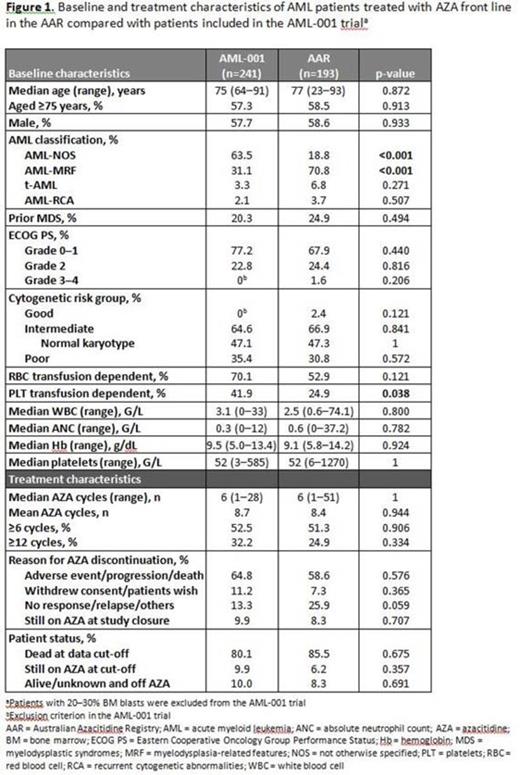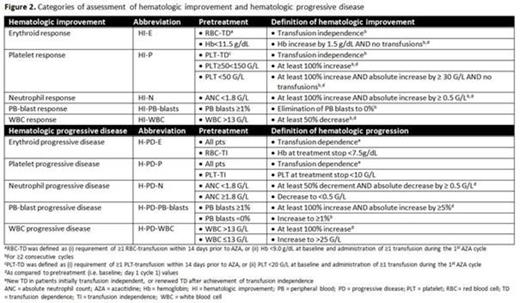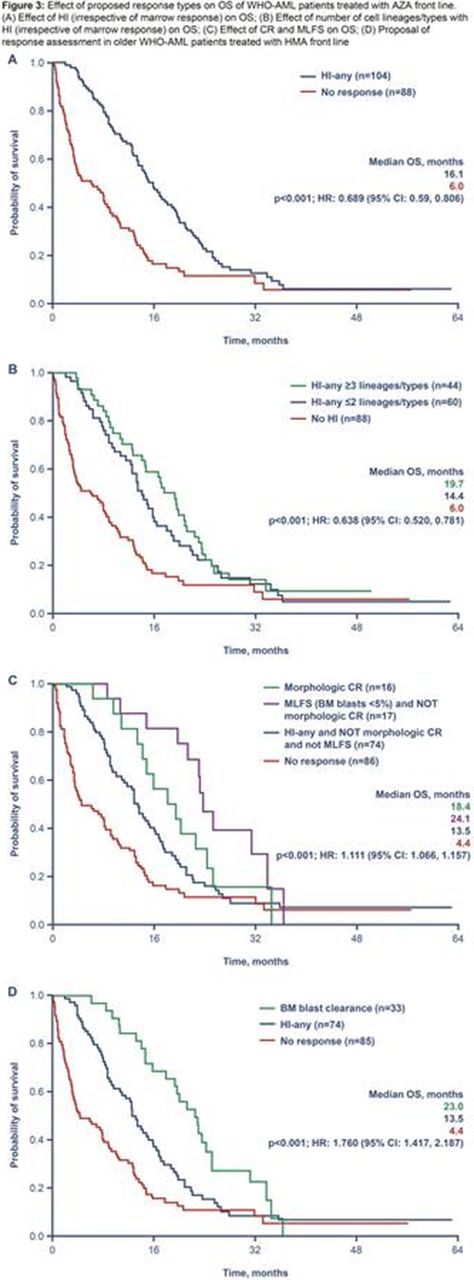Abstract
Background
Current response criteria for AML were established for and validated in younger patients (pts) fit for and treated with intensive chemotherapy (IC) in an era before hypomethylating agents (HMA) were available. According to these criteria:
1 Achievement of morphologic complete response (CR; defined as bone marrow blasts [BMB] <5%, absolute neutrophil count >1.0G/L, platelets ≥100G/L and red blood cell transfusion independence) is a prerequisite for cure, and is deemed the sole outcome associated with improved overall survival (OS)1
2 Pts without morphologic CR are considered non-responders1
3 Morphologic leukemia free state (MLFS; defined as <5% BMB, irrespective of cytopenias) is considered inferior to CR
4 Hematologic improvement (HI) without BMB clearance is considered treatment failure1,2
However, evidence is accumulating that these definitions may not be applicable to older AML pts treated with HMA. For example, achievement of CR with HMA may not be necessary for clinical benefit and prolonged OS.3-5
We have previously shown that older AML pts achieving HI according to myelodysplastic syndrome (MDS) criteria6 have clinical benefit from extended azacitidine (AZA) treatment.3,4 In addition, treatment goals and modalities differ for HMA vs IC. Thus, the question arises whether current response criteria remain valid for older AML pts unfit for IC.
Aims and methods
To define new response criteria, including the 1st criteria for assessment of HI, for older AML pts unfit for IC with the intention of keeping them as simple to implement as possible. Human errors in response assessment according to these proposed criteria were excluded by the development of algorithms for automated computational calculation from data entered into the eCRF. We next assessed the supplementary value of HI in addition to BMB reduction, as well as the value of HI irrespective of BMB reduction, with regards to predicting treatment outcomes.
Results
In total, 193 AML pts receiving AZA 1st line were included in this analysis. Baseline and treatment characteristics were mostly comparable to those of AML pts included in a recent phase 3 clinical trial (Fig 1).7 Overall, 5 categories of HI and hematologic progression were defined, using: erythrocytes (E), platelets (P), neutrophils (N), peripheral blood blasts, and elevated white blood cells (Fig 2). We based our definitions on IWG 2006 MDS criteria and adapted these for the more aggressive disease biology and kinetics of AML, and treatment goals and modalities of HMA.
Our data indicate that:
1 AML pts achieving HI (irrespective of BMB reduction) had significantly longer OS than those without HI (16.1 vs 6.0 mo, p<0.001; Fig 3A)
2 OS was prolonged irrespective of the cell lineage in which HI occurred (17.1, 17.5 and 18.0 mo for pts with HI-N, HI-E or HI-P, respectively)
3 OS correlated with the number of cell lineages/types in which HI was achieved (6.0 vs 14.4 vs 19.7 mo [p<0.001] for HI in 0 vs 1-2 vs >2 lineages/types; Fig 3B)
4 Pts with MLFS did not have worse OS than pts with CR (Fig 3C)
5 Definition of response according to our proposed criteria resulted in clinically meaningful separation of 3 response types with significant differences in median OS: 23.0 (CR or MLFS) vs 13.5 (HI and not CR or MLFS) vs 4.4 mo (non-responders) (p<0.001; Fig 3D)
Conclusions
While achievement of CR according to IWG 2003 criteria1 remains the primary goal for AML pts treated with IC, we guardedly introduce new response criteria for pts unfit for IC treated with non-curative treatment such as HMA. Applying these criteria to our large real world cohort, we show that pts achieving HI in the absence of BMB clearance (considered non-responders using current criteria)1, had a significant survival benefit from continued AZA treatment compared to pts with no HI. We conclude that these patients should be considered as responders and kept on treatment, and hypothesize that achievement of HI could be used as a surrogate parameter for response in pts unable or unwilling to undergo BM biopsy for response assessment. This proposal requires concerted validation efforts and we hope that our data stimulate cooperations.
References
1 Cheson BD JCO 2003;21:4642
2 Lopez G Blood 2001;98:329;abs 1388
3 Pleyer L J Hematol Oncol 2013;6:32
4 Pleyer L Ann Hematol 2014;93:1825
5 Schuh AC Haematologica 2015;100:abs P575
6 Cheson BD Blood 2006;108:419
7 Dombret H Blood 2015;126:291
Pleyer:AOP Orphan Pharmaceuticals: Honoraria; Novartis: Consultancy, Honoraria; Bristol-Myers Squibb: Consultancy, Honoraria; Celgene: Consultancy, Honoraria. Off Label Use: Vidaza (azacitidine) is indicated for the treatment of adult AML patients who are not eligible for hematopoietic stem cell transplantation with 20-30% blasts and multi-lineage dysplasia, according to WHO classification. This cohort also includes AML patients with >30% bone marrow blasts.. Burgstaller:Celgene: Consultancy, Honoraria, Research Funding; Novartis: Honoraria; Mundipharma: Honoraria; AOP Orphan Pharmaceuticals: Honoraria, Research Funding. Girschikofsky:Pfizer: Honoraria, Research Funding; Mundipharma: Consultancy, Honoraria. Sill:Celgene: Membership on an entity's Board of Directors or advisory committees, Research Funding. Thaler:AOP Orphan: Research Funding. Halter:Medical University Innsbruck: Employment. Zebisch:Celgene: Honoraria. Pichler:Celgene: Honoraria. Pfeilstöcker:Celgene: Consultancy, Honoraria, Research Funding, Speakers Bureau; Novartis: Consultancy, Speakers Bureau. Autzinger:Wilhelminenspital: Employment. Lang:Celgene: Consultancy. Geissler:Celgene: Membership on an entity's Board of Directors or advisory committees. Geissler:Klinikum Klagenfurt: Employment. Sperr:Celgene: Consultancy; Ariad: Consultancy. Hojas:LKH Fürstenfeld: Employment. Greil:Amgen: Honoraria, Research Funding; Pfizer: Honoraria, Research Funding; Boehringer-Ingelheim: Honoraria; Astra-Zeneca: Honoraria; Cephalon: Consultancy, Honoraria, Research Funding; Celgene: Consultancy; Ratiopharm: Research Funding; GSK: Research Funding; Sanofi Aventis: Honoraria; Novartis: Honoraria; Janssen-Cilag: Honoraria; Genentech: Honoraria, Research Funding; Eisai: Honoraria; Mundipharma: Honoraria, Research Funding; Merck: Honoraria; Bristol-Myers-Squibb: Consultancy, Honoraria; AOP Orphan: Research Funding; Roche, Celgene: Honoraria, Research Funding.
Author notes
Asterisk with author names denotes non-ASH members.




